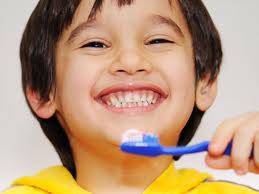The bacteria that cause cavities is microscopic and they are only visible with a high powered microscope. The pediatric dentist has only a limited number of methods available to detect decay. The most obvious is a visual clinical examination. The other most common method is through the use of radiographs (x-rays). Many cavities are not clinically visible, they cannot be seen just by looking, and many cavities can not be seen on the radiographs, therefore both an exam and radiographs are necessary for a thorough evaluation. There are several other electronic devices that can be used to check for cavities. These devices are as yet not widely used.
Obvious decay in Primary Molars
The pediatric dentist will discuss with the child's parents the necessity for treating your child. The front primary teeth last until 5 or 6 years of age. The back primary teeth usually last till 11 or 12 or even longer. The permanent molars (6 year molars) erupt behind the baby teeth at around age 6. They form behind the last baby molars, no teeth fall out for them to erupt.
Sometimes no treatment may be indicated when teeth may be soon falling out. Sometimes there are areas too small to repair and in the pediatric dentist's opinion may not decay further, and they are put on a "watch" basis. When it becomes necessary to restore the primary teeth, you should discuss the treatment option with your pediatric dentist. Most routine cavities are repaired using composite (white) fillings today. The newer materials are strong, long lasting and easy to place. Many fillings will be hard to detect from natural teeth, both children and parents like them.
However, cavities that have large areas of breakdown, even into the nerve, will require more extensive repair. Some may require nerve treatments (pulpectomy or pulpotomy), and caps or crowns. The pediatric dentist can explain the types of treatment to you.
It is important to repair decayed baby teeth. The necessity for restoring primary teeth to normal form and function is an essential health component. Decayed teeth, if left to continue to rot, will lead to pain, infection and loss of teeth. A child in pain is something we want to prevent. A severe infection, in rare cases, can affect the entire body and hospitalization may be needed. Some teeth, if lost prematurely, will cause shifting and orthodontic problems in the future. Also, in young children, the front teeth may require restoration to allow the young children to have a happy smile. Esthetics are just as important for the developing child.




